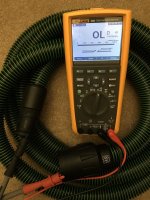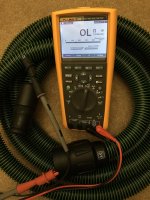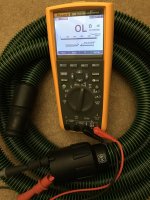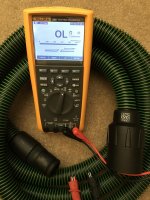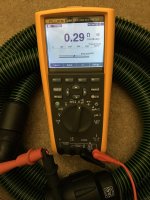I'll state up front that I own an Oneida Ultimate Dust Deputy (UDD) and have ever since I bought my CT Mini a number of years ago. I went through all the issues between Festool and Oneida with the UDD not maintaining a clean electrical path between the tool and the vacuum that resulted in Oneida coming out with an updated cyclone made out of conductive plastic and several other enhancements that improved the conductivity of the UDD.
Personally this all made me very careful to make sure that I have a clean electrical path but, I've never tried to measure it; until now. On my cheap Ridgid shop vac I notice that after vacuuming for a while there is sawdust sticking to the vacuum hose and that has become my indicator that there is a static charge building up from the flow of air through the hose. I've never noticed this on the Festool vac but curiosity got the better of me this evening and I pulled out my trusty multimeter and started measuring the conductivity (resistance) of the hose and fittings between the tool and the vacuum.
What I found surprised me. The Festool hose absolutely showed it was conductive as did the cyclone and all the UDD parts from Oneida. However, the Festool hose fittings, even though they were marked AS, did not show any conductivity. [eek] Clearly there can't be a complete electrical path from the tool to the vacuum if the hose fittings aren't made of conductive plastic. [huh]
I'd greatly appreciate it if someone could educate me on this as I'm very confused; especially after all the fuss that was made over the UDD not being conductive a few years ago and the potential damage to a Festool vac if a clean electrical path from tool to vac is not maintained.
Thanks in advance
Personally this all made me very careful to make sure that I have a clean electrical path but, I've never tried to measure it; until now. On my cheap Ridgid shop vac I notice that after vacuuming for a while there is sawdust sticking to the vacuum hose and that has become my indicator that there is a static charge building up from the flow of air through the hose. I've never noticed this on the Festool vac but curiosity got the better of me this evening and I pulled out my trusty multimeter and started measuring the conductivity (resistance) of the hose and fittings between the tool and the vacuum.
What I found surprised me. The Festool hose absolutely showed it was conductive as did the cyclone and all the UDD parts from Oneida. However, the Festool hose fittings, even though they were marked AS, did not show any conductivity. [eek] Clearly there can't be a complete electrical path from the tool to the vacuum if the hose fittings aren't made of conductive plastic. [huh]
I'd greatly appreciate it if someone could educate me on this as I'm very confused; especially after all the fuss that was made over the UDD not being conductive a few years ago and the potential damage to a Festool vac if a clean electrical path from tool to vac is not maintained.
Thanks in advance

